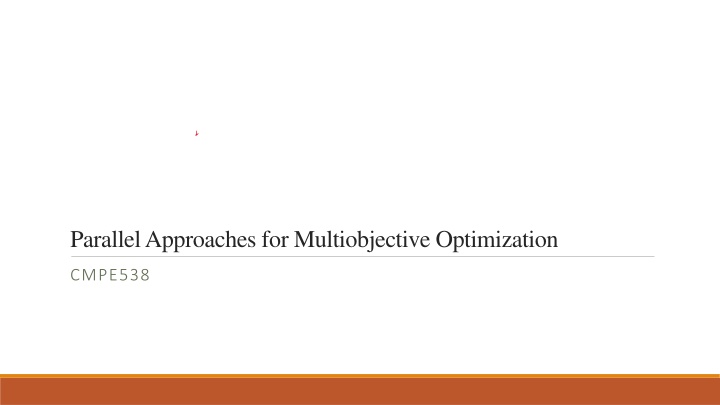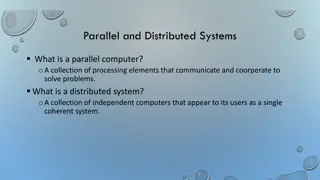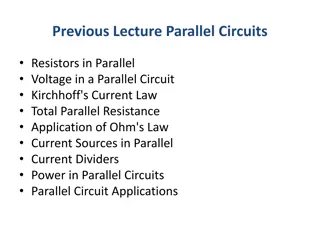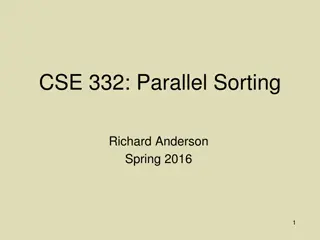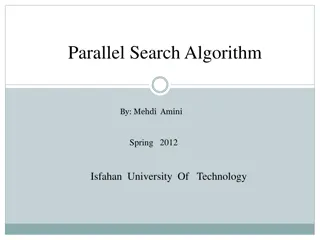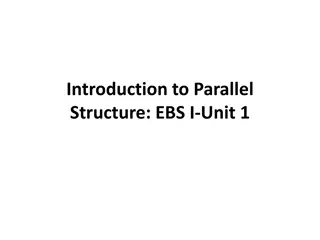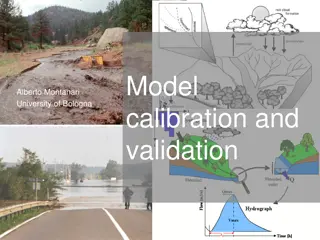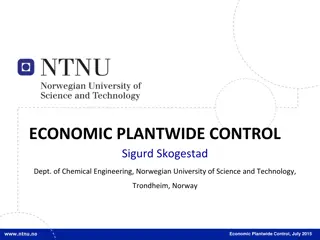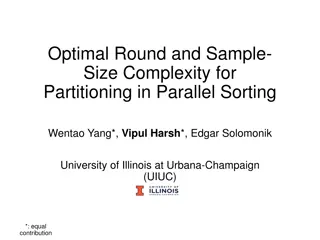Parallel Approaches for Multiobjective Optimization in CMPE538
This lecture provides a comprehensive overview of parallel approaches for multiobjective optimization in CMPE538. It discusses the design and implementation aspects of algorithms on various parallel and distributed architectures. Multiobjective optimization problems, often NP-hard and time-consuming, are tackled using exact methods for precise Pareto fronts and metaheuristics for efficient approximations. Utilizing parallel and distributed computing enhances the speed, precision, quality, and robustness of solutions while addressing large-scale problems. Different parallel models for metaheuristics, including self-contained parallel cooperation, offer strategic solutions for improving algorithm performance in vast search spaces.
Download Presentation

Please find below an Image/Link to download the presentation.
The content on the website is provided AS IS for your information and personal use only. It may not be sold, licensed, or shared on other websites without obtaining consent from the author.If you encounter any issues during the download, it is possible that the publisher has removed the file from their server.
You are allowed to download the files provided on this website for personal or commercial use, subject to the condition that they are used lawfully. All files are the property of their respective owners.
The content on the website is provided AS IS for your information and personal use only. It may not be sold, licensed, or shared on other websites without obtaining consent from the author.
E N D
Presentation Transcript
This lecture presents a general overview of parallel approaches for multiobjective optimization. And covers the design aspect of the algorithms as well as the implementation aspects on different parallel and distributed architectures.
Multiobjective optimization problems are often NP-hard, complex and CPU time consuming. Exact methods can be used to find the exact Pareto front (or a subset of the front), but they are impractical to solve large problems as they are time and memory consuming. On the other hand, metaheuristics provide the approximated Pareto fronts in a reasonable time. However, they also remain time-consuming for solving large problems.
Parallel and distributed computing are used in the design and implementation of multiobjective optimization algorithms to speedup the search. Also, they are used to improve the precision of the used mathematical models, the quality of the obtained Pareto fronts, the robustness of the obtained solutions, and to solve large scale problems.
Parallel Models for Metaheuristics Different parallel models for metaheuristics have been proposed in the literature. They follow three major hierarchical models such as: Self-contained parallel cooperation (between different algorithms) Problem independent intra-algorithm parallelization Problem dependent intra-algorithm parallelization
Self-Contained Parallel Cooperation This group of parallel algorithms containing the Island model is used for parallel systems with very limited communication. In the island model, every processor runs an independent MOEA using a separate (sub)population. The processors might cooperate by regularly exchanging migrants which are good individuals in their subpopulations. These algorithms are also suitable for problems with large search spaces where a large population is being required. The large population is then being divided into several subpopulations.
In every processor, an optimization algorithm with selection and recombination operators is being carried out on a subpopulation.
Two main groups: (1) Cooperating Subpopulations: These methods are based on partitioning the objective/search space. In this group, the population is divided into subpopulations. The number of subpopulations and the way the population is divided are the two key issues. (2) Multi-start Approach: Here, each processor independently runs an optimization algorithm.
Group 1: Cooperating Subpopulations These algorithms attempt to distribute the task of finding the entire Pareto optimal front among participating processors. By this way, each processor is destined to find a particular portion of the Pareto-optimal front. In fact, the population of a MOEA is divided into a number of independent and separate subpopulations resulting in several small separate MOEAs executing simultaneously which have the responsibility to find the (Pareto-)optimal solutions in their own search region. Each MOEA could have different operators, parameter values, as well as a different structure. In this model, some individuals within some particular subpopulations occasionally migrate to another one.
Unrestricted migration topology ring migration topology neighborhood migration topology
Group 2: Multi-start Approach This model introduced by Mezmaz et al. (2006) consists of several parallel local search algorithms which are independently run on several (also heterogeneous) processors. The basic idea of using such a model is that running several optimization algorithms with different initial seeds is more valuable than executing only one single run for a very long time. Synchronous versus Asynchronous models
Level 2: Problem Independent Parallel Intra Level 2: Problem Independent Parallel Intra- -algorithm algorithm During an optimization, we have to evaluate fitness values of candidates of solution (individuals). If we use benchmark problems/simple applications to evaluate fitness values, the calculation time is negligible. However, a real application sometimes needs huge computational time, e.g., using computational fluid dynamics (CFD), electro-magnetic field analysis, finite element method (FEM) etc.. In this situation, total calculation time becomes too huge and it is generally impossible to obtain a certain result in a reasonable calculation time.
To tackle this problem, a parallel calculation is often used. The basic idea is shown in Fig. This type of parallelization is called master master- -slave model or global slave model or global parallelization parallelization
The four steps in the execution loop (fitness evaluation, recombination, mutation, and selection) must occur sequentially. Mutation cannot operate until recombination finishes.
Distributing objective function evaluations over a number of slave processors can generally be implemented in three different ways 1. Evenly distribute population members across the slaves where each slave performs all k objective function evaluations. 2. Evenly distribute (sets of) population members across (sets of) k slaves where each slave performs one of the k objective function evaluations. 3. Evenly distribute each objective function calculation for the entire population across multiple processors
Level 3: Problem Dependent Parallelization In this model, problem-dependent operations are parallelized. In general, the interest here is the parallelization of the evaluation of a single solution (different objectives and/or constraints). The parallel models may be based on the data partitioning or task partitioning. This model is useful in MOPs with time and/or memory intensive objectives and constraints. In the last section, the evaluations in a generation are parallelized. However, even if the evaluations are parallelized, one fitness evaluation is sometimes still time-consuming. To solve this problem, we discuss the parallelization of each evaluation in this section. Possible parallelization of one fitness evaluations are listed as follows:
Possible parallelization of one fitness evaluations are listed as follows: 1. Several solvers: Consider a multiobjective optimization of a car design as an example. To design a car, several disciplines should be considered. Examples are to optimize the air flow around a car and the toughness of materials of a car. To optimize this problem, two independent solvers are necessary, i.e. CFD solver for the air flow and FEM for the toughness of materials. If we use one computer to evaluate two objectives, many users will firstly use the CFD to obtain the first objective function and secondly use the FEM to obtain the second objective function or vise versa. Some users will execute the CFD and the FEM at the same time. However, the total calculation time is nearly same with the above case because the computational resources are shared by two solvers. However, it is reasonable to execute the CFD and the FEM at the same time on different computers. Although the idle time, caused by the different calculation time of the CFD and the FEM, is not avoidable, the total calculation time becomes shorter.
2. Decomposition of one fitness evaluation: Consider the evaluation of a big product which consists of several parts. A simple idea to reduce the computational time is evaluation of each part and merging of them. Generally, CFD calculation for a big product is terribly time-consuming and has huge memory consumption. To tackle these problems, domain decomposition method (DDM) is often used in CFD research field, e.g., Elleighy and Tanaka (2001). Calculation domain is divided into several parts and assigned to different computers. Each computer calculates only the assigned part. To balance all calculation, the boundary condition is shared regularly. This division reduces the calculation time and memory consumption. However, since the boundary condition is shared regularly, rich connections among several computers are necessary. Furthermore, the user should take care of the division to reduce boundary and the balance of calculation cost on each computer.
3. Multiple runs for one fitness evaluation: Fitness evaluation sometimes needs several runs of a solver with different calculation conditions. An example is an optimization with uncertainty. Recently, robustness of fitness value against the variance of design parameters has gathered much attention, in particular, by researchers an practitioners researching for a real application. In a real application, it is impossible to generate a product based on optimal design parameters because some variations are unavoidable. Therefore, it is very important to obtain a robust and (nearly) optimal design. To find robust and (nearly) optimal design, multiple runs of a solver are sometimes necessary. Assume that an optimizer obtains the design parameter x. To see the robustness against variance of the design parameter, the fitness values of x + dx and x dx should also be evaluated. In this situation, it is reasonable to execute three solvers with different design parameters on different computers simultaneously. By simultaneous execution, calculation time will be reduced.
